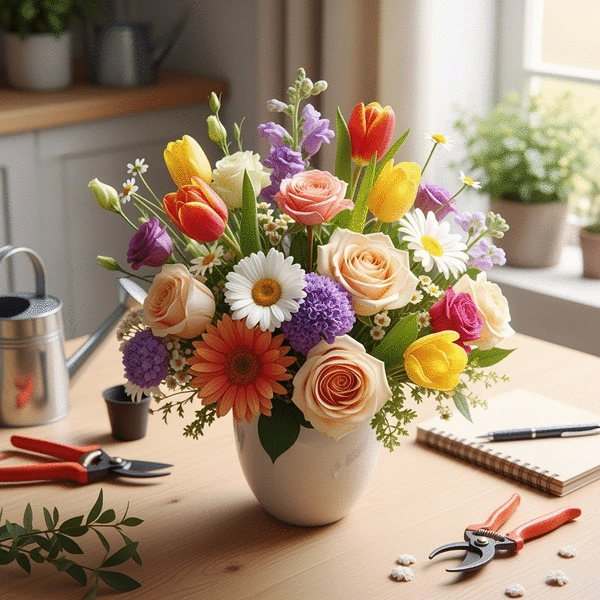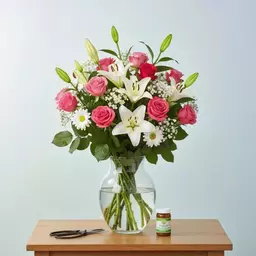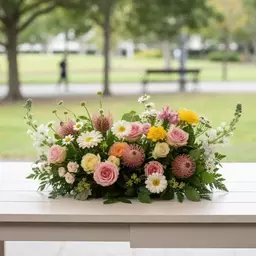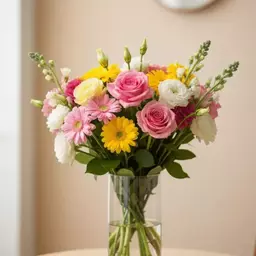Are you ready to elevate your flower care game and enjoy vibrant blooms for longer? The right techniques can transform your floral arrangements into lasting beauties. Follow these essential guidelines to ensure your flowers remain fresh, fragrant, and fabulous!
What You Will Learn
- Proper flower maintenance significantly extends the lifespan of your blooms, turning a short-lived bouquet into a lasting display of beauty.
- Regular water changes and keeping the vase clean are crucial steps to prevent bacterial growth and ensure your flowers thrive.
- Trimming stems at an angle enhances water absorption, while removing excess foliage keeps arrangements looking fresh and vibrant.
- Choosing the right water and vase setup, including water quality and temperature, plays a critical role in maintaining flower health.
- Proper placement away from direct sunlight and drafts helps prevent wilting and promotes longevity in your arrangements.
- Addressing common challenges like wilting and discoloration promptly can save your flowers and keep them looking their best.
- Innovative approaches, such as smart technology and eco-friendly practices, can enhance your flower care routine sustainably and efficiently.
Essential Guidelines for Fresh Flower Care
Key areas to focus on for maintaining your fresh flowers include Proper Maintenance, Common Challenges, and Step-by-Step Care Process.
Proper Maintenance
- Fresh flowers need clean water.
- Regular trimming helps them absorb more hydration.
- Removing wilted leaves keeps arrangements looking fresh.
Common Challenges
- Wilting and drooping flowers due to lack of water.
- Discoloration from overwatering or bacteria.
- Bacterial growth causing cloudy water.
Step-by-Step Care Process
- Trim stems at an angle before placing them in water.
- Change the water every 2-3 days.
- Remove dead petals immediately.
Water Quality and Vase Setup
- Use fresh, clean water at room temperature.
- Ensure your vase is clean to prevent bacteria.
- Consider using flower food for enhanced care.
Essential Guidelines for Fresh Flower Care at Home
Caring for fresh flowers at home can be a delightful experience! It allows you to enjoy the beauty and fragrance of your favorite blooms while also creating a vibrant atmosphere in your living space. However, many people may not realize that with the right care, your flowers can last much longer, bringing joy and charm to your home. At the Pakenham Florist Guide, I'm excited to share some essential guidelines that will help you maintain your floral treasures beautifully!
Understanding the Importance of Proper Flower Maintenance
Did you know that proper flower maintenance can significantly extend the lifespan of your blooms? Fresh flowers are living organisms that require specific conditions to thrive. By understanding their needs, you can enjoy the vibrant colors and scents for a more extended period. Think of it as a small investment of time for a big payoff in joy and beauty! For more detailed guidance, the University of New Hampshire Extension offers comprehensive care instructions for flowering gift plants.
- Fresh flowers need clean water.
- Regular trimming helps them absorb more hydration.
- Removing wilted leaves keeps arrangements looking fresh.
Common Care Challenges and Solutions
Even with the best intentions, flower care can sometimes feel challenging. Many people encounter issues like wilting, discoloration, or shorter-than-expected lifespans. But don't worry! There are simple solutions to these common problems that can help you get the most out of your flowers.
- Water Changes: Frequently changing the water can prevent bacterial growth.
- Stem Trimming: Regularly trim the stems to maintain proper hydration.
- Vase Cleanliness: Ensure your vase is clean to avoid harmful bacteria.
Step-by-Step Process for Caring for Fresh Flowers
Now that we’ve covered the importance of flower care, let's dive into a practical step-by-step process to keep your fresh blooms looking stunning! Follow these guidelines to ensure your flowers stay vibrant and lively for as long as possible.
Preparing Flowers for Optimal Hydration
To start, it’s crucial to prepare your flowers properly for hydration. This helps them absorb as much water as possible right from the beginning. When flowers are cut, air can enter the stems, preventing them from drinking water effectively. Here’s how to do it right!
Trimming Stems for Better Water Absorption
One of the simplest yet most effective steps you can take is to trim the stems of your flowers. Cut them at an angle, about one to two inches from the bottom. This angled cut increases the surface area, allowing them to drink more water.
Removing Excess Foliage to Enhance Longevity
Another quick tip is to remove any excess leaves from the stems, especially those that will sit below the waterline. This not only keeps the water cleaner but also helps the flowers put their energy into blooming rather than sustaining unnecessary foliage.
- Always use clean, sharp scissors or knife.
- Cut stems underwater to prevent air bubbles.
Choosing the Right Water and Vase Setup
The water and vase you use can significantly impact your flowers' health. Let’s explore how to make the best choices for your floral arrangements!
Water Quality and Temperature Considerations
Using fresh, clean water is essential. Tap water is generally fine, but if you notice any chlorine smell, consider using filtered water instead. Additionally, the temperature matters! Flowers prefer room temperature water, which makes it easier for them to absorb. For further insights on cut flower care, the Brooklyn Botanic Garden provides valuable information.
Cleaning Your Vase for Bacteria Prevention
Before adding flowers to a vase, make sure it is clean. Rinse it with hot soapy water, then rinse again with clear water. This helps eliminate any bacteria that might harm your flowers, allowing them to thrive.
Utilizing Water Additives for Enhanced Flower Care
Did you know that some simple additives can help your flowers last even longer? You can create your own flower food using sugar and lemon juice or purchase pre-made solutions from your local florist. These additives provide essential nutrients to your blooms!
- Mix 1 part sugar with 1 part lemon juice in water.
- Store-bought flower food often contains essential nutrients.
Ideal Placement for Fresh Flowers
Once you've prepared your flowers, the next step is to find the perfect spot to display them. Proper placement is key to ensuring they remain fresh and vibrant!
Understanding Sunlight Exposure and Temperature Preferences
Most flowers prefer bright, indirect sunlight. Direct sunlight can cause them to wilt quickly. Aim for a cool, well-lit area in your home, such as a dining table or countertop away from windows. This way, your flowers can soak in the light without getting overheated.
Avoiding Drafts and Heat Sources
It’s also essential to keep flowers away from drafts, heaters, or air conditioning vents. Sudden temperature changes can stress your blooms, leading to wilting. Think about your flowers as you would a houseplant—keeping them in a stable environment is crucial!
Ensuring Proper Air Circulation Around Your Flowers
Lastly, ensure there’s enough air circulation around your flowers. Good airflow helps prevent mold and keeps your arrangements looking fresh. So, avoid crowding them with other items or flowers!
- Position them away from direct sunlight.
- Keep away from heating or cooling devices.
- Allow space for air to circulate around arrangements.
By following these guidelines for flower care, you'll be well on your way to creating a vibrant, floral haven in your home! Remember, **proper flower maintenance** is not just about keeping them alive—it's about celebrating the beauty they bring to your life. Happy flower caring!
We Want to Hear From You!
What challenges have you faced while caring for fresh flowers? Share your experiences and tips with us!
Addressing Advanced Troubleshooting in Flower Care
Even with the best intentions, sometimes our lovely flowers can face a few hiccups. As a passionate floral enthusiast, I know how disheartening it can be when a beautiful bouquet starts to wilt or shows signs of distress. But don’t worry! Understanding how to identify and solve these common flower problems can make all the difference in keeping your arrangements looking vibrant and fresh.
Let’s explore some common challenges you might encounter and how to tackle them effectively. Being proactive can save your stunning blooms and keep your floral displays cheerful!
Identifying and Solving Common Flower Problems
It’s essential to keep an eye on your flowers to catch any issues early. Here are some of the most common problems and their solutions:
- Wilting and Drooping Flowers: This often indicates a lack of water. Try to hydrate them quickly by placing the stems in a bucket of water for at least an hour.
- Discoloration: Yellowing petals might be a sign of overwatering or bacterial growth. Ensure you’re not crowding the vase and change the water often.
- Bacterial Growth: If your water looks cloudy, it’s time to change it! Regularly clean the vase and trim the stems to prevent bacteria from thriving.
Dealing with Wilting and Drooping Flowers
When flowers start to droop, it’s often due to insufficient water uptake. I recommend quickly submerging the stems in water or even giving them a fresh cut at an angle to help. This can be a lifesaver!
Another tip? Make sure they’re not too hot or too cold. Temperature extremes can stress flowers and lead to wilting. Find a happy medium!
Tackling Discoloration and Bacterial Growth
Discoloration, especially yellowing leaves, can be disheartening. Check if the stems are submerged in clean, fresh water, and remove any leaves that may be sitting in the water. This step can help reduce bacteria.
You can also add a few drops of bleach to the water. It’s a common trick that many florists recommend to keep bacteria at bay. Just a little goes a long way!
Managing Fungal Infections in Flower Arrangements
If you notice fuzzy spots on your flowers, this could mean a fungal infection. To tackle this, remove affected blooms immediately and ensure better air circulation around your arrangement.
Using a clean vase and changing the water regularly will help create a less hospitable environment for fungi. Trust me, a little prevention goes a long way!
Innovative Approaches to Flower Care
In the age of technology, it’s exciting to see how we can enhance our flower care routine. At Pakenham Florist Guide, I love discovering new methods to keep flowers fresh and vibrant!
From smart gadgets to eco-friendly practices, exploring innovative approaches can help you maintain your floral displays with ease and sustainability.
Smart Technology Enhancements for Flower Maintenance
Have you ever thought about using technology to care for your flowers? Here are some cool options to consider:
- Smart Watering Systems: These systems can monitor moisture levels and automatically water your plants.
- Sensor Apps: Some apps measure light and humidity, ensuring your flowers are always in their ideal environment.
- Digital Reminders: Set alerts for when it’s time to change the water or trim the stems!
Eco-Friendly Practices for Sustainable Flower Care
Being eco-conscious is always in style! Here are some simple, sustainable practices for flower care:
- Use Recycled Water: If you have leftover water from cooking or cleaning, use it to nourish your flowers!
- Compost Flower Scraps: Instead of tossing wilted petals, add them to your compost for rich soil.
- Choose Local Blooms: Supporting local florists like those in Pakenham not only boosts the community but also reduces carbon footprints!
Quick Tips and Reminders for Easy Reference
Let’s wrap up with some quick tips to keep your flower care routine straightforward and enjoyable! Remember, these little reminders can make a big difference in maintaining those gorgeous blooms.
Care Checklist for Fresh Flowers
Here’s a handy checklist to keep in mind:
- Change the water every 2-3 days.
- Trim stems at an angle regularly.
- Keep flowers away from direct sunlight and drafts.
- Remove any dead petals immediately.
Frequently Asked Questions about Flower Care
Many flower enthusiasts wonder about common care questions. Here are some FAQs to help:
- How often should I change the water for my flowers?
You should change the water every 2-3 days, or immediately if it appears cloudy, to prevent bacterial growth.
- Why is it important to trim flower stems at an angle?
Trimming stems at an angle increases the surface area for water absorption, helping the flowers hydrate more efficiently and prolonging their freshness.
- What kind of water is best for fresh flowers?
Fresh, clean tap water at room temperature is generally best. If your tap water has a strong chlorine smell, consider using filtered water. For additional tips, the University of Missouri Extension offers further guidance on proper cut flower care.
- How can I prevent my flowers from wilting quickly?
To prevent wilting, ensure regular water changes, trim stems at an angle, remove excess foliage below the waterline, and place flowers away from direct sunlight, drafts, and heat sources.
- Can I use homemade flower food, or should I buy it?
Both options are viable! You can create homemade flower food using sugar and lemon juice for nutrients. Store-bought flower food is also effective and often contains a balanced mix of nutrients and bacterial inhibitors.
Seasonal Care Tips for Your Flower Arrangements
Different seasons can affect how you care for your flowers. Here are some seasonal tips:
- Spring: Keep an eye on pests that awaken during this time!
- Summer: Be extra diligent about water levels—heat can dry them out quickly.
- Fall and Winter: Indoor heating can be harsh; consider moving flowers to cooler areas.
At Pakenham Florist Guide, we believe that fresh flowers should bring joy without the stress. With these tips and tricks, you’ll be well on your way to creating beautiful arrangements that last! What flower care tips have you found most helpful? Let’s keep the conversation blooming!
Recap of Key Points
Here is a quick recap of the important points discussed in the article:
- Proper flower maintenance can significantly extend the lifespan of your blooms.
- Always use clean water and frequently change it to prevent bacterial growth.
- Trim stems at an angle and remove excess foliage to enhance water absorption.
- Use room temperature water and ensure your vase is clean for optimal hydration.
- Place flowers in bright, indirect sunlight, away from drafts and heat sources.
- Identify common problems like wilting or discoloration and troubleshoot effectively.
- Consider innovative and eco-friendly practices to enhance your flower care routine.
- Follow a care checklist and seasonal tips for maintaining beautiful arrangements year-round.




